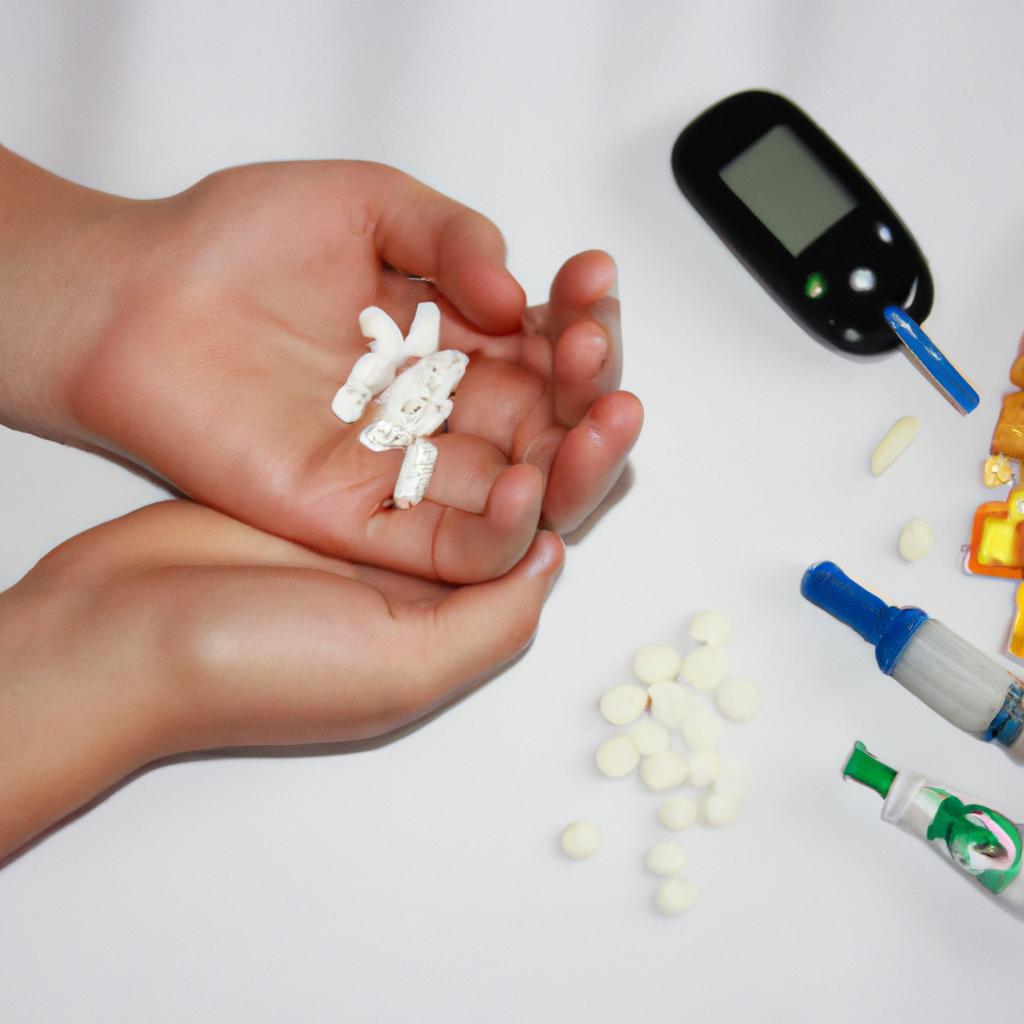Diabetes, a chronic metabolic disorder characterized by elevated blood glucose levels, affects millions of people worldwide. This complex condition is classified into several types, each with its own unique characteristics and underlying causes. Understanding the different types of diabetes is crucial for accurate diagnosis, appropriate management, and effective prevention strategies. For instance, consider the case of Sarah, a 45-year-old woman who was recently diagnosed with gestational diabetes during her second trimester of pregnancy. This example highlights the importance of recognizing specific variations within the overarching category of diabetes and underscores the need for an in-depth exploration of these diverse subtypes.
One prominent type of diabetes is Type 1 Diabetes (T1D), also known as insulin-dependent or juvenile-onset diabetes. T1D typically manifests in childhood or early adulthood and occurs when the body’s immune system mistakenly attacks and destroys pancreatic beta cells responsible for producing insulin. Without adequate insulin production, individuals with T1D require lifelong external insulin administration to regulate their blood sugar levels effectively. Another prevalent form is Type 2 Diabetes (T2D), which accounts for approximately 90% to 95% of all diagnosed cases globally. Unlike T1D, T2D often develops later in life due to various risk factors such as obesity , sedentary lifestyle, poor diet, and genetic predisposition. In T2D, the body becomes resistant to the effects of insulin or fails to produce enough insulin to maintain normal blood glucose levels. Initially, lifestyle modifications such as dietary changes, increased physical activity, and weight loss may be sufficient to manage T2D. However, some individuals may eventually require oral medications or insulin injections to control their blood sugar levels.
Gestational diabetes is a temporary form of diabetes that occurs during pregnancy and affects about 3-10% of pregnant women. It arises when hormonal changes impair the body’s ability to use insulin effectively. Gestational diabetes usually resolves after childbirth but increases the risk of developing type 2 diabetes later in life for both the mother and child.
There are also less common types of diabetes such as monogenic diabetes, which results from specific gene mutations affecting insulin production or function. Other forms include cystic fibrosis-related diabetes, steroid-induced diabetes (caused by long-term use of corticosteroid medications), and drug-induced diabetes (triggered by certain medications).
It is important for individuals with any type of diabetes to regularly monitor their blood sugar levels, follow a healthy diet, engage in regular physical activity, take prescribed medications as directed by healthcare professionals if needed, and attend regular check-ups with their healthcare team. Diabetes management is essential for preventing complications such as cardiovascular disease, kidney damage, nerve damage (neuropathy), eye problems (retinopathy), foot ulcers/infections (diabetic foot), and other related health issues.
Overall, understanding the different types of diabetes allows for tailored approaches to diagnosis, treatment plans, and prevention strategies based on each individual’s unique needs and circumstances.
Type 1 Diabetes
Type 1 diabetes is a chronic autoimmune disease characterized by the body’s inability to produce insulin. Insulin plays a crucial role in regulating blood sugar levels, and without it, glucose cannot enter cells for energy production. As a result, individuals with type 1 diabetes require lifelong insulin therapy to manage their condition effectively.
To illustrate the impact of this disease, consider the case of Sarah, a 12-year-old girl diagnosed with type 1 diabetes. Prior to her diagnosis, Sarah experienced symptoms such as excessive thirst, frequent urination, unexplained weight loss, and fatigue. After undergoing diagnostic tests that revealed high blood sugar levels and low insulin production, she was diagnosed with type 1 diabetes.
The emotional toll of living with type 1 diabetes can be significant. Individuals often face daily challenges managing their condition while striving for normalcy in their lives. Here are some common emotions experienced by those affected:
- Fear: Fear of complications arising from improper management or unpredictable fluctuations in blood sugar levels.
- Frustration: Frustration due to the constant vigilance required in monitoring diet, medication intake, and physical activities.
- Anxiety: Anxiety about long-term health effects and uncertainties surrounding future treatment advancements.
- Isolation: Feelings of isolation resulting from misconceptions or lack of understanding among peers and society regarding the disease.
Understanding these emotional aspects is crucial in providing comprehensive care for individuals with type 1 diabetes.
In addition to its profound emotional impact, type 1 diabetes also has wider societal implications. The following table provides an overview of key statistics related to this disease:
| Statistic | Value |
|---|---|
| Global prevalence | >10% |
| Average age at diagnosis | <30 years |
| Life expectancy reduction | ~20 years |
| Annual healthcare expenditure | $XX billion |
These figures highlight the significant burden that type 1 diabetes places on individuals, families, and healthcare systems worldwide.
Moving forward, our discussion will delve into the next section about “Type 2 Diabetes.” This form of diabetes differs from type 1 in its etiology and management strategies. Understanding these distinctions is crucial for effective diagnosis and treatment approaches.
Type 2 Diabetes
Transitioning from the previous section on Type 1 Diabetes, we now delve into another prevalent form of diabetes known as Type 2 Diabetes. To illustrate its impact, let us consider a hypothetical case study involving Sarah, a middle-aged woman who has recently been diagnosed with this condition.
Sarah’s journey highlights the multifaceted nature of Type 2 Diabetes and underscores the importance of understanding its complexities. This chronic metabolic disorder is characterized by insulin resistance or reduced insulin sensitivity in body tissues, coupled with impaired insulin secretion by pancreatic beta cells. Unlike Type 1 Diabetes, which is primarily caused by an autoimmune response targeting these beta cells, Type 2 Diabetes typically develops over time due to various factors such as genetic predisposition, sedentary lifestyle, obesity, and poor dietary choices.
To better comprehend the implications of this condition, here are four key points regarding Type 2 Diabetes:
- Prevalence: It accounts for approximately 90% of all diabetes cases globally and is increasing at an alarming rate.
- Risk Factors: Apart from genetics and age (typically affecting individuals above the age of 45), modifiable risk factors include excess weight or obesity, physical inactivity, unhealthy diet patterns high in refined sugars and saturated fats.
- Complications: If left unmanaged, Type 2 Diabetes can lead to severe complications such as cardiovascular diseases, kidney damage (nephropathy), nerve damage (neuropathy), vision impairment (retinopathy), and even limb amputations.
- Management: Lifestyle modifications including regular exercise routines and adopting a balanced diet play a crucial role in managing blood glucose levels. In some cases where necessary, oral medications or injectable insulin may also be prescribed.
In addition to these essential aspects of Type 2 Diabetes, it is worth noting that there are distinct differences between this type and others. The table below provides a concise comparison among different types of diabetes:
| Type 1 Diabetes | Type 2 Diabetes | Gestational Diabetes | |
|---|---|---|---|
| Cause | Autoimmune | Insulin | Hormonal changes |
| Age of onset | Usually young | Typically older | During pregnancy |
| Treatment | Insulin | Lifestyle | Blood glucose control |
Understanding the characteristics and management strategies associated with each type aids in tailoring appropriate interventions for individuals diagnosed with diabetes, including Sarah. Transitioning into the subsequent section on Gestational Diabetes, we explore how this specific form affects women during pregnancy and its potential implications.
Gestational Diabetes
However, it is important to note that there are other types of diabetes that also warrant attention due to their unique features and implications for individuals’ health. One such type is Gestational Diabetes.
Gestational Diabetes occurs during pregnancy when women without previously diagnosed diabetes develop high blood glucose levels. This condition usually resolves after childbirth; however, it can have significant consequences for both the mother and the baby if not properly managed. For instance, uncontrolled gestational diabetes can lead to complications such as preeclampsia (high blood pressure), preterm birth, or even stillbirth. It is crucial for pregnant women to undergo routine screenings to detect this condition early on and receive appropriate treatment and care.
To further understand the various aspects of different diabetes types, let us delve into some key points:
-
Risk Factors: Certain factors increase an individual’s susceptibility to developing specific types of diabetes:
- Genetic predisposition: Some forms of diabetes have a strong hereditary component.
- Lifestyle choices: Sedentary lifestyles, poor dietary habits, and obesity can contribute to the development of certain types of diabetes.
- Hormonal changes: Pregnancy-related hormonal shifts play a role in gestational diabetes onset.
-
Complications: Each form of diabetes carries its own set of potential complications:
| Type | Complications |
|---|---|
| Type 2 | Cardiovascular disease, neuropathy (nerve damage), kidney problems |
| Gestational | Increased risk of cesarean delivery, macrosomia (large babies) |
-
Management: Effective management strategies vary depending on the type of diabetes:
- Type 2 Diabetes often requires lifestyle modifications like diet control and exercise alongside medication.
- Gestational Diabetes may necessitate regular monitoring of blood glucose levels, diet modifications, and insulin therapy if necessary.
Understanding the distinct features and implications of each type of diabetes is crucial for healthcare professionals to provide appropriate treatment plans and support. In the subsequent section, we will explore another form known as Maturity-Onset Diabetes of the Young (MODY), which highlights additional nuances in the realm of diabetes. By examining these different types comprehensively, a more holistic understanding can be achieved in addressing this widespread health condition.
Maturity-Onset Diabetes of the Young (MODY)
Gestational Diabetes is a type of diabetes that occurs during pregnancy. It typically develops around the 24th to 28th week of gestation and affects approximately 7% of all pregnancies worldwide (Centers for Disease Control and Prevention, 2021). While most cases resolve after delivery, women who have had gestational diabetes are at an increased risk of developing type 2 diabetes later in life.
For instance, let us consider the case study of Sarah, a 32-year-old woman who was diagnosed with gestational diabetes during her second trimester. Throughout her pregnancy, she diligently monitored her blood glucose levels and followed a carefully planned diet prescribed by her healthcare provider. After giving birth, Sarah’s blood sugar returned to normal levels, but she remained vigilant about maintaining a healthy lifestyle to reduce her future risk of developing type 2 diabetes.
Understanding the implications and potential consequences of gestational diabetes is crucial for both expectant mothers and healthcare professionals. Here are some key points to consider:
- Risk factors: Women who are overweight or obese before pregnancy, have a family history of diabetes, or belong to certain ethnic groups (such as Hispanic, African American, Native American, or Asian) are more likely to develop gestational diabetes.
- Complications: Untreated or uncontrolled gestational diabetes can lead to complications such as preeclampsia (high blood pressure), preterm birth, cesarean delivery, and macrosomia (large birth weight).
- Management: Treatment usually involves monitoring blood glucose levels regularly through self-monitoring or continuous glucose monitoring devices. Dietary modifications and regular physical activity may also be recommended. In some cases, insulin therapy may be necessary.
- Postpartum follow-up: After delivery, women diagnosed with gestational diabetes should undergo postpartum screening for persistent impaired glucose tolerance or overt diabetes within six weeks. Lifestyle changes should continue beyond pregnancy to prevent or delay the onset of type 2 diabetes.
Table: Potential Complications of Untreated Gestational Diabetes
| Complication | Description |
|---|---|
| Preeclampsia | High blood pressure during pregnancy |
| Preterm birth | Delivery before 37 weeks gestation |
| Cesarean delivery | Surgical delivery of the baby |
| Macrosomia | Large birth weight (over 9 pounds) |
In conclusion, gestational diabetes is a temporary form of diabetes that affects pregnant women and requires careful management to ensure both maternal and fetal well-being. By understanding the risk factors, potential complications, appropriate management strategies, and the importance of postpartum follow-up, healthcare professionals can provide comprehensive care for women with this condition.
Latent Autoimmune Diabetes in Adults (LADA)
Transition: Building upon our understanding of Maturity-Onset Diabetes of the Young (MODY), let us now delve into another intriguing type of diabetes known as Latent Autoimmune Diabetes in Adults (LADA).
Latent Autoimmune Diabetes in Adults (LADA)
To illustrate the impact of LADA, consider the case study of John, a 38-year-old male who presented with gradually increasing blood sugar levels and persistent fatigue. Initially misdiagnosed with Type 2 diabetes due to his age and lack of insulin dependence, further investigation revealed autoantibodies associated with autoimmune destruction of pancreatic beta cells—a hallmark feature of LADA. This realization highlighted the importance of distinguishing between different types of diabetes for appropriate management strategies.
Understanding LADA requires an exploration of its unique characteristics:
- Progression: Unlike traditional Type 2 diabetes that develops slowly over time, LADA exhibits a slower but progressive loss of pancreatic function similar to Type 1 diabetes.
- Age: Although commonly diagnosed in adulthood, individuals with LADA are typically older than those diagnosed with classic Type 1 diabetes.
- Autoimmunity: The presence of islet cell antibodies or other autoantibodies indicates an immune-mediated destruction process occurring within the pancreas.
- Treatment Approach: As LADA shares features from both Type 1 and Type 2 diabetes, treatment options may differ depending on disease progression and individual patient factors.
Let us now examine these characteristics more closely through a comparative table highlighting key differences among various types of diabetes:
| Characteristic | MODY | LADA | Type 1 Diabetes | Type 2 Diabetes |
|---|---|---|---|---|
| Onset | Early childhood/adolescence | Adulthood | Childhood/adulthood | Adulthood |
| Genetic Inheritance | Autosomal dominant | Polygenic | Multifactorial | Polygenic |
| Autoimmunity | Uncommon | Possible (islet cell antibodies) | Present | Not typically present |
In summary, LADA represents a distinct type of diabetes characterized by its progressive nature, older age at diagnosis compared to Type 1 diabetes, and the presence of autoimmunity. Recognizing these differences is crucial for tailoring treatment plans and optimizing patient outcomes.
Transition: Moving forward, we will now explore another intriguing aspect of diabetes known as Secondary Diabetes without delay.
Secondary Diabetes
Section H2: Secondary Diabetes
Secondary diabetes, also known as type 3 diabetes, is a less common form of the disease that occurs due to an underlying health condition or external factor. Unlike primary types of diabetes such as type 1 and type 2, secondary diabetes is not caused by genetic factors or lifestyle choices but rather by other medical conditions or medications. To illustrate this point, let us consider the hypothetical case study of Mr. Johnson.
Mr. Johnson, a 55-year-old man with no history of diabetes, was diagnosed with pancreatic cancer last year. During his treatment process, he noticed unusual symptoms like increased thirst and frequent urination, prompting him to seek medical advice. After further investigation, it was determined that Mr. Johnson had developed secondary diabetes as a result of his pancreatic tumor interfering with insulin production.
There are various causes for secondary diabetes; some common examples include:
- Pancreatic diseases (e.g., pancreatitis)
- Hormonal disorders (e.g., Cushing’s syndrome)
- Medications (e.g., glucocorticoids)
- Genetic syndromes (e.g., Down syndrome)
It is important to note that while secondary diabetes shares similarities with other forms of the disease in terms of symptoms and complications, its management can differ significantly based on the underlying cause. A holistic approach involving both treating the root cause and managing blood sugar levels becomes crucial in these cases.
To provide a comprehensive understanding of secondary diabetes, we present the following table outlining key differences between primary and secondary types:
| Primary Diabetes | Secondary Diabetes |
|---|---|
| Caused by genetics/lifestyle | Caused by other medical conditions/medications |
| Insulin deficiency/resistance | Varies depending on underlying cause |
| Lifelong management required | Management depends on addressing root issue |
| High prevalence rate | Lower prevalence rate |
This information serves as a reminder that diabetes is a complex disease with various forms, and secondary diabetes highlights the importance of considering underlying factors when managing this condition.
In summary, secondary diabetes represents a distinct category within the spectrum of diabetes. It develops as a consequence of certain medical conditions or medications rather than genetic or lifestyle factors. Understanding the causes and distinguishing features of secondary diabetes allows healthcare professionals to tailor treatment plans accordingly and address both the primary condition and blood sugar control in an integrated manner. By doing so, patients like Mr. Johnson can receive optimal care for their unique circumstances, improving their overall well-being.
 Web Firma
Web Firma



